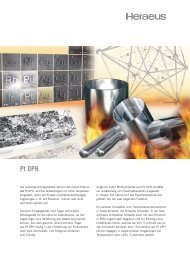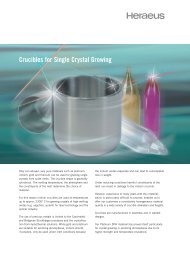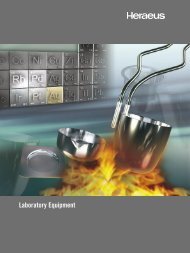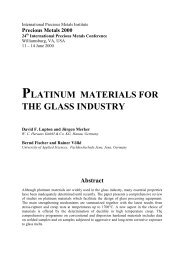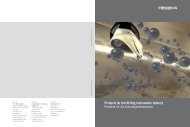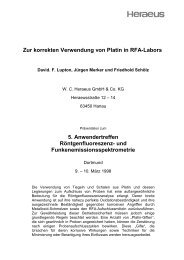Design and Manufacture of Bushings for Glass Fibre Production
Design and Manufacture of Bushings for Glass Fibre Production
Design and Manufacture of Bushings for Glass Fibre Production
Create successful ePaper yourself
Turn your PDF publications into a flip-book with our unique Google optimized e-Paper software.
<strong>Design</strong> <strong>and</strong> <strong>Manufacture</strong> <strong>of</strong> <strong>Bushings</strong> <strong>for</strong> <strong>Glass</strong> <strong>Fibre</strong> <strong>Production</strong><br />
constant, i.e. the rate <strong>of</strong> glass melting on the per<strong>for</strong>ated sheet must closely match the<br />
rate <strong>of</strong> fibre drawing. This is achieved by careful temperature control both in the<br />
design <strong>and</strong> the operation <strong>of</strong> the bushing.<br />
Figure 2a: Indirect or marble bushing.<br />
Figure 2b: Direct melt bushing.<br />
Figure 2: Operating principle <strong>of</strong> bushings <strong>for</strong> indirect <strong>and</strong> direct melt processes.<br />
Direct melt process<br />
This single-stage process is now the most widely used method <strong>for</strong> the production <strong>of</strong><br />
textile glass fibres. A number <strong>of</strong> bushings are fed with molten glass directly from a<br />
central melting furnace or “tank” via a channel or “<strong>for</strong>ehearth”. The glass flows into<br />
the bushing through a finely per<strong>for</strong>ated sheet which serves mainly to homogenise the<br />
temperature distribution in the molten glass. The fibres are again drawn through the<br />
tips in the tip-plate <strong>of</strong> the bushing.<br />
Methods <strong>for</strong> manufacturing glass fibre bushings<br />
Heraeus has two basic techniques <strong>for</strong> manufacturing the tip-plates <strong>of</strong> bushings. In the<br />
first process, the tips are cut from seamless drawn platinum alloy tubes which are<br />
then inserted into a plate with pre-punched holes <strong>and</strong> welded into position. With the<br />
second technique, a thicker sheet is used <strong>and</strong> the tips are pressed from this sheet by<br />
– 3 –



